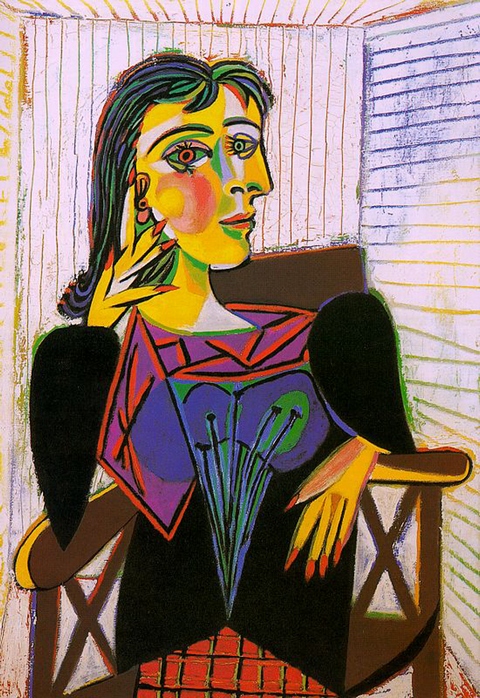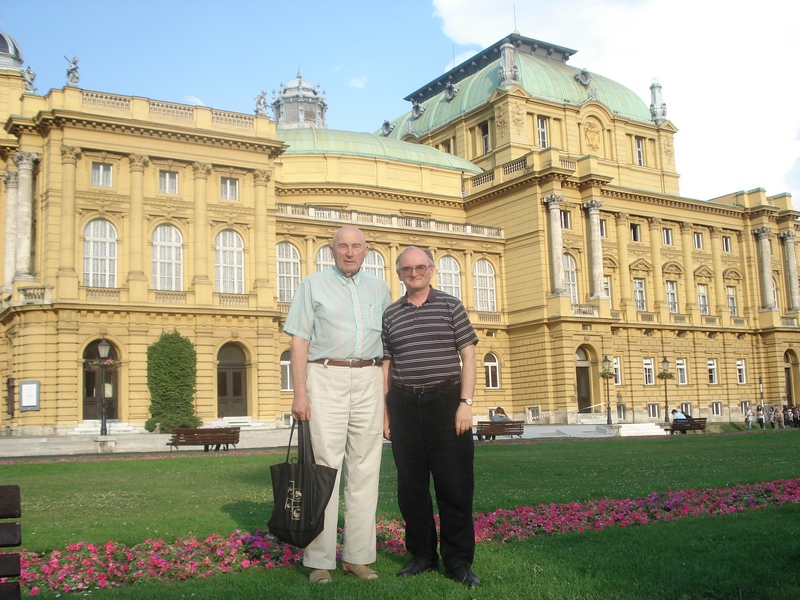
Sponsored Ads
|
» Home
» Human Rights » Dora Maar robbed by The Direction of French Cultural Patrimony
» Home
» Education » Dora Maar robbed by The Direction of French Cultural Patrimony
» Home
» Culture And Arts » Dora Maar robbed by The Direction of French Cultural Patrimony
| Dora Maar robbed by The Direction of French Cultural Patrimony |
| By Predrag Brkljačić |
Published
06/9/2011
|
Human Rights , Education , Culture And Arts
|
Unrated
|
|
|
|
Mr. Predrag Brkljačić seeking his rights from France
Dora Maar - photographer and muse of Picasso. Her original name was Henriette Theodora Markovitch (1907-1997), born in Tours, France. Her father Josip Marković - Jose Marcovic or Jose Markovich, distinguished Argentinean architect, is from Croatia.
Dorina baka Barbara Marković po ocu je imala dva sina. Prvo Josipa Markovića, Dorinog oca, i drugog Stjepana Markovića, koji postaje otac Dragice Marković, udate Brkljačić, majke g. Predraga Brkljačića. Josip odlazi u Pariz i zatim kao arhitekt u Buenos Aires. Svu svoju zaradu odnosi u Pariz. Dora upoznaje Picassa i postaje njegov slavni model. Ali još za života je bila jako čuvana od francuskih vlasti. Naravno zbog Picassovih slika. Nitko ju nije smio uznemiravati niti k njoj blizu doći. Čim je umrla genealozi su pošli u potjeru za rodbinom. Nađoše Dragicu Brkljačić rođ. Marković, kćerku od Stjepana. Ona je bila najbliža živuća rođakinja Dore Maar. Dragica je u tom času bila treće koljeno i po francuskom zakonu je trebala sve od Dore naslijediti. Ali se je Direkcija domovinske kulturne bastine (La direction general des patrimoines) brzo snašla i pogazila vladavinu prava i privatnog vlasništva, i sve uzela za sebe. Članovi šestog koljena u Hrvatskoj i Francuskoj dobili su novčani iznos od oko sedam milijuna eura, uz potpisani uvjet da ne potražuju umjetnička djela, koja vrijede daleko više. Za ilustracija, samo jedno od navedenih djela prodano je 2011 za više od sto milijuna dolara.
Kao posljedica djelovanja Francuske direkcije kulturne baštine, Dragici Marković - Brkljačić, iako prva rođakinja, i to u trećoj grani, je otuđeno nasljeđe. Umrla je 2005., bez mogućnosti da spriječi štetu koja je učinjena njoj i sinu Predragu Brkljačiću, njezinom jedinom potomku. On je uzalud pokušavao naći pravdu: čini se da se odvjetnici boji dirati u francusku vladu.
Dva američka genealoga iz država UTAH i California, su svojim istraživanjem potrdili i ovjerili najveću rodbinsku bliskost gđe. Dragice Brkljačić i njezina sina Predraga s Dorom Maar.
Taj zaključak podupiru i dokumenti iz Hrvatskog državnog arhiva i Francuski arhiv.
Za mene je veoma je ponižavajuće da Dorin osobni muzej nije bio zakonski zaštićen od strane Direkcije kulturne zaklade. Umjesto toga, neke su stvari prodane na dražbi.
Predrag Brkljačić, SAD
denisebrk2@yahoo.com
|
Dora's grandmother Barbara Marković on the father's side had two sons. The first one was Josip (Joseph), Dora's father, and the second one Stjepan (Stephan) Marković, who becomes the father of Dragica Marković, married Brkljačić, mother of mr. Predrag Brkljačić. Josip Marković goes to Paris, and then as architect goes to Buenos Aires. He takes all his earnings to Paris. Dora gets acquainted with Picasso, and becomes his famous model. But still, during her lifetime she was very protected by French authorities because of Picasso's paintings she owned. No one could disturb her or get close to her. As soon as she died the geneaologists began to look for the relatives, and they found Dragica Marković, the daughter of Stjepan Marković. Dragica Marković married Brkljačić was the closest living relative of Dora Maar. At that moment she was the third branch, and according to French law she had to inherit all of the inheritance. But, the Direction of French Cultural Patrimony (La direction general des patrimoines) disregarded the realm of Law and Private property, and took everything for the state. Members of the sixth branch in Croatia and France got the sum of seven million Eu. They had to sign an agreement of not claiming anything of future sales of Picasso's paintings previously belonging to Dora Maar. As an illustration, only one of Picasso's pictures was sold in 2011 for more than hundred million dollars.
As a consequence of the French Cultural Patrimony action, Dragica Marković - Brkljačić, although first cousin and the third in line, was robbed of her inheritence. She passed away in 2005 without having been able to rectify the wrong that was done her and her son Predrag Brkljacic who is her sole heir. He has been trying in vain all these years to find justice: it seems that every lawyer is afraid to tackle the French government.
Two american geneaologists from the states of UTAH and Califormia, with their research confirmed and verified the closest family ties of Mrs. Dragica Brkljačić and her son Predrag with Dora Maar. This conclusion is supported by existing documents from Croatian State Archives and French Register.
It was very offending to me that Dora's personal museum was not protected under the French Cultural Exception law. Instead, certain things were sold in auction.
Predrag Brkljačić, USA
denisebrk2@yahoo.com
| Predrag Josip Brkljačić 1331,Victoria Dr. # D Fullerton, CA 92831 USA
Poslije Dorine smrti genealoški kabinet Andriveau je dobio službenu dozvolu da traži najbližu Dorinu rodbinu. Dorin stan je bio službeno zapečaćen i jedino je Andriveau mogao službeno ući u njega, ali kad je Andriveau išao u Dorin stan na njihovo veliko iznenađenje tamo su našli službenike iz Patrimoine koji su tamo ušli ilegalno. Patrimoine službenici su tamo bili zbog Picasovih slika u vlasništvu Dore Maar, a i da neslužbeno kopaju i uništavaju dokumente koje su smatrali nepogodnima za ostvarivanje njihovih ciljeva tj. nelegalnog prisvajanja Dorinih Picassovih slika. Oni su sve eliminirali što bi moglo ih spriječiti u prisvajanju tih slika. Nekim čudom je prošao oglas u hrvatskim novinama da se traže potomci Stjepana Markovića, rođenog u Sisku od majke Barbare Marković, 29.6 1886., dokument kojeg je netko pošten nasao u Dorinom stanu. Patrimoine je najprije odpustila Dorinog bilježnika gosp. Tetard-a i postavila svoga bilježnika. Poslije toga su pojačali pritisak na Andriveau-a da eliminira moju majku Dragicu Brkljačić kao nasljednicu Dore Maar. Po zakonu Patrimoine može dobiti Picassove slike jedino ako nema najbliže živuće rodbine. Dora je imala u stanu dokaze da ima svog ujaka Stjepana Markovića koje je Patrimoine uništila svojom ilegalnom provalom u Dorin stan.
After Dora's death the genealogical cabinet Andriveau was officially designated to look for Dora's closest relatives. Dora's appartement was sealed and only Andriveau could officially enter it, but when they went to the Dora's appartement to their biggest surprise they found there present the Patrimony people who were there illigally. They were after the Picasso's paintings in possession of Dora Maar. First, they fired Dora's notary Maitre Tetar(d) and appointed theirs. Then they put pressure on Andriveau to eliminate my mother Dragica Brkljacic as heir of Dora Maar. By law they can get Dora 's Picasso's paintings only if there are no living relatives.
Predrag Brkljačić
|
 Pablo Picasso: Portrait of Dora Maar
Dora Maar
Dora Maar (November 22, 1907 – July 16, 1997) was a French photographer, poet and painter of Croatian descent, best known for being a lover and muse of Pablo Picasso. She was born Henriette Theodora Markovitch in Tours, Western France to a Jewish family. Her father, Josip Marković, was a Croat architect, famous for his work in South America; her mother, Julie Voisin, was from Touraine, France. Dora grew up in Argentina. Before meeting Picasso, Maar was already famous as a photographer. She also painted. She met Picasso in January 1936 on the terrace of the Café les Deux Magots in Saint-Germain-des-Prés, Paris, when she was 29 years old and he 54. The famous poet Paul Éluard, who was with Picasso, had to introduce them. Picasso was attracted by her beauty and self-mutilation (she cut her fingers and the table playing "the knife game"; he got her bloody gloves and exhibited them on a shelf in his apartment). She spoke Spanish fluently, so Picasso was even more fascinated. Their relationship lasted nearly nine years. Maar became the rival of Picasso's blonde mistress, Marie-Thérčse W, who had a newborn daughter with Picasso, named Maya. Picasso often painted beautiful, sad Dora, who suffered because she was sterile, and called her his "private muse." For him she was the "woman in tears" in many aspects. During their love affair, she suffered from his moods, and hated that in 1943 he had found a new lover, Françoise Gilot. Picasso and Paul Éluard sent Dora to their friend, the psychiatrist Jacques Lacan, who treated her with psychoanalysis. She made herself better known in the art world with her photographs of the successive stages of the completion of Guernica, which Picasso painted in his workshop on the rue des Grands Augustins, and other photographic portraits of Picasso. Together, she and Picasso studied printing with Man Ray. Maar kept his paintings for herself until her death in 1997. They were souvenirs of her extraordinary love affair, which made her famous forever. In Paris, still occupied by the Germans, Picasso left to her a drawing from 1915 as a goodbye gift in April 1944; it represents Max Jacob, his close friend who had just died in the transit camp of Drancy after his arrest by the Nazis. He also left to her some still lifes and a house at Ménerbes in Provence. After her long relationship with Picasso ended, Maar struggled to regain her emotional footing. This was complicated by the sudden death of her best friend, Nusch Eluard, wife of the poet Paul, in 1946. Likewise, her mother had also died unexpectedly in 1941, leaving Maar without family or long-time close friends.
But eventually Maar returned to her previous social circle, which included famous society hostesses and art patrons such as Marie-Laure de Noailles and Lise Deharme. She also found solace in Roman Catholicism. The author Mary Caws quotes Maar as saying, "After Picasso, God." She spent her last years living between Paris and Provence in the house Picasso had given her.
Although she had other male friends in her life, such as the writer James Lord, a close friend who lived with her in the house in Provence in the 1950s, no one replaced Picasso for her.
Maar's poetry is notable for its themes of near-religious meditation. Caws in her 2000 book on Maar quotes several pieces such as one entitled "5 November", thought to have been written in 1970:
Pure as a lake boredom
I hear its harmony
In the vast cold room
The nuance of light seems eternal
All is simple I admire
the full totality of objects.
Others were more openly religious:
The soul that still yesterday wept is quiet -- it's exile suspended
a country without art only nature
Memory magnolia pure so far off
I am blind
and made from a bit of earth
But your gaze never leaves me
And your angel keeps me.
By the 1980s she had few friends left, but still wrote poetry and returned to photography. An exhibition of her paintings in 1990 at the Marcel Fleiss gallery was a success, as was another in Valencia, Spain in 1995, just two years before her death. She died 89 years of age in Paris on July 16, 1997. She is buried with her family at Clamart Cemetery in Hauts de Seine.
Maar's first photography exhibition ws at the Galerie de Beaune in Paris, in 1937. She had one-woman exhibitions of painting in Paris at Jeanne Bucher (1943) and Pierre Loeb (1945).
After a period of semimonastic life devoted to mystical experience, began exhibiting her paintings again during the 1950s. Towards the end of her life, renounced her earlier association with Surrealism.
Maar supported herself in the 1920s and 1930s as a commercial photographer with portraits and advertisements, and pursued street photography and avant-garde experimentation in her spare time. She was prominent in Parisian art and photography circles.
In her photographs, Maar imbued blind beggars and impoverished children with unusual dignity; made distinctively austere Surrealist collages, montages and setup images (a pair of shoes seemingly walking on a beach); and created two haunting works using the ceiling of a cathedral, turned upside down.
She got on film what might be called street Surrealism: a discarded doll, hanging from a nail on a wood fence; a group of tussling children with an extra pair of legs. Her photographic work has a distinctive formal clarity and emotional directness.
On May 3, 2006, one of Picasso's portraits of her, Dora Maar au Chat ("Dora Maar with Cat") was auctioned at Sotheby's at a closing price of US$ 95,216,000, making it the world's second most expensive painting ever sold at auction. The winning bidder chose to remain anonymous; however, it was later revealed that he was bidding on behalf of a Russian buyer.
Two Picasso art works depicting Maar were stolen in France in 1999. First, an oil on canvas, "Dora Maar", was stolen from a boat on the French Riviera. The boat's crew was arrested and Lloyds offered a 530,000 euro reward. The painting is currently registered with the FBI's National Stolen Art File. FBI reports that the picture was stolen from a Saudi yacht in Antibes between March 7-11, 1999. It is likely the owner was a Saudi royal Picasso aficionado.
Just weeks after the boat theft on the Riviera, on April 1, 1999, a bronze sculpture of the face of Maar was taken from a public square in Paris.
Maar was portrayed by Julianne Moore in the 1996 film Surviving Picasso.
Source allart.biz
|
Monograph about Dora Maar
Alicia Dujovne Ortiz: Dora Maar, prisoničre du regard, Le livre de poche, Paris 2003, 358 pp, ISBN 9782253114727 (2253114723)
Retrace la vie de la photographe Henriette Théodora Markovitch, dite Dora Maar (1907-1997) : son enfance en Argentine, son arrivée ŕ Paris ŕ l'âge de 20 ans, sa participation au courant surréaliste, sa carričre de photographe, ses rencontres avec Man Ray, P. Eluard, Brassaď, A. Breton, M. Jacob, sa vie auprčs de L. Chavance, G. Bataille, puis P. Picasso, sa fin de vie solitaire et recluse...
Dora Maar, Henriette Théodora Markovitch de son vrai nom, est née ŕ Paris en 1907 d'un pčre croate, architecte, et d'une mčre française, catholique fervente. Aprčs une enfance austčre passée ŕ Buenos Aires, elle revient ŕ vingt ans dans sa ville natale et s'y impose comme photographe surréaliste. Muse de Man Ray, compagne du cinéaste Louis Chavance puis de Georges Bataille, elle ne tarde pas ŕ faire sien un cercle esthétique qui révolutionne le monde de l'art de l'entre-deux-guerres. Intellectuelle torturée, artiste ŕ la conscience politique extręme, elle deviendra " la femme qui pleure ", amante de Picasso livrée aux exigences du génie, que leur rupture rendra folle, cloîtrée dans un mysticisme solitaire jusqu'ŕ sa mort, en 1997. Ses portraits peints par Picasso seront alors vendus aux enchčres, et son héritage âprement disputé puisque Dora choisit de tout léguer ŕ l'Eglise. De Cocteau ŕ Lacan, c'est toute une époque que dépeint Alicia Dujovne Ortiz. Au détour d'une enquęte psychologique passionnante, elle fait défiler dans ces pages une pléiade d'artistes d'avant-garde et de grands esprits, et dresse le portrait d'une femme-image toujours mystérieuse, ŕ laquelle la critique contemporaine attribue enfin le rôle qui lui revient.
We apologize for the problem with French accents.
Dora Maar, her photo self-portrait 1935
Translated into Croatian
Dora Maar, pravim imenom Henriette Théodora Markovitch, rođena je u Parizu 1907. od oca Hrvata, arhitekta, i majke Francuskinje. Nakon djetinjstva provedenog u Buenos Airesu, u dobi od dvadeset godina vraća se u rodni grad i tamo postaje fotografkinjom nadrealizma, muza fotografa Mana Raya, družica redatelja Louisa Chavancea, a zatim i pjesnika Georgesa Bataillea. Dora Maar pripadala je krugu stvaratelja koji su značajno promijenili svijet umjetnosti u razdoblju između dva rata. Intelektualka i umjetnica naglašene političke svijesti postat će Picassovom ljubavnicom i inspiracijom mnogih njegovih djela, njegova "Žena koja plače"... Nakon prekida njihove veze, Dora Maar povući će se u samotni misticizam, sve do svoje smrti 1997. godine. Njezini portreti koje je naslikao Picasso prodani su na dražbi, a njezini nasljednici pronađeni su u Hrvatskoj i Francuskoj.
|
 Mr. Predrag Brkljačić and Darko Žubrinić in front of the Croatian National Theatre in Zagreb, 2011. The Direction of French Cultural Patrimony (La Direction General des Patrimoines) disregarded the realm of Law and Private property, and took everything from Dora Maar's inheritance for the state. The Croatian citizen Mrs. Dragica Marković married Brkljačić was left without any inheritance contrary to existing French law. Mr. Predrag Brkljačić, the son of late Mrs. Dragica, and Croatian-American citizen, professor of English, French and Spanish, tries to get some just solution. Formated for CROWN by prof.dr. Darko Žubrinić
Distributed by www.Croatia.org . This message is intended for Croatian Associations/Institutions and their Friends in Croatia and in the World. The opinions/articles expressed on this list do not reflect personal opinions of the moderator. If the reader of this message is not the intended recipient, please delete or destroy all copies of this communication and please, let us know!
|
Related Articles
Related Links
Comments
-
Comment #1
(Posted by Brkljacic Lana I lorena)
Moja baka Dragica Brkljacic Rod Markovic imala je osim sina Predraga i(pok) sina Zdravka koji ima 2 kcerke LANU I LORENU
-
Comment #2
(Posted by Hrvoje Barbir Barba)
Gosp. Nenad Bach je danas na svom FB profilu objavio ovaj clanak. Zaintrigirao me jer ponesto znam o Dori Markovic preko gosp. Mladena Urema, knjizevnika, urednika i povjesnicara umjetnosti iz Rijeke. On je utvrdio jos jednu interesantnu rodbinsku vezu izmedju Dore Markovic i jednog naseg poznatog knjizevnika. J.P.Kamova! Izgleda da je taj tako rano ugaseni Policev gen kasnije eksplodirao upravo u fotografkinji, slikarici i pjesnikinji Dori Maar. Sasvim je zgodna ta teorija, vrlo zanimljiva i neobicna. A kazem, ne znam je li gosp. Brkljacic s time upoznat.Zato sam postirao ovaj komentar, da ga gosp. Brkljacic vidi. Pozz, H.B.B.
Submit Comment
|
|